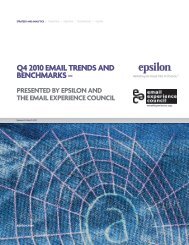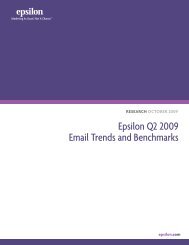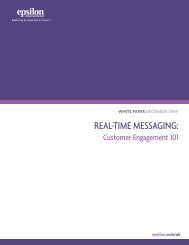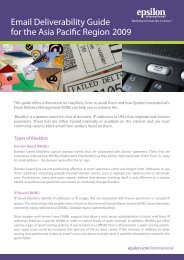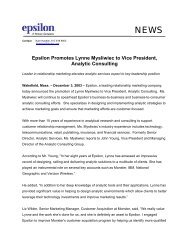customer experience marketing: realizing the promise of ... - Epsilon
customer experience marketing: realizing the promise of ... - Epsilon
customer experience marketing: realizing the promise of ... - Epsilon
Create successful ePaper yourself
Turn your PDF publications into a flip-book with our unique Google optimized e-Paper software.
STRATEGY AND ANALYTICS / TARGETING / CREATIVE / TECHNOLOGY / DIGITAL<br />
CUSTOMER EXPERIENCE MARKETING:<br />
REALIZING THE PROMISE OF DYNAMIC<br />
INTERACTIONS<br />
A WINTERBERRY REPORT SUMMARY<br />
epsilon.com
STRATEGY AND ANALYTICS / TARGETING / CREATIVE / TECHNOLOGY / DIGITAL<br />
INTRODUCTION<br />
Customer Experience Marketing (CEM) is <strong>the</strong> sum <strong>of</strong> information, technology and process that<br />
allows a company to maximize <strong>the</strong> value <strong>of</strong> its interaction – it’s more than just <strong>marketing</strong>. CEM is<br />
about turning every email, phone call and point-<strong>of</strong>-sale transaction into an opportunity to enrich<br />
a pr<strong>of</strong>itable long term relationship.<br />
In April 2011, <strong>Epsilon</strong> and Winterberry Group set out to discover how marketers are planning and<br />
activating real life CEM approaches in <strong>the</strong>ir businesses. Based on over 100 in-person, telephone and<br />
electronic surveys with leading marketers, service providers and o<strong>the</strong>r knowledgeable sources, <strong>the</strong><br />
report: Customer Experience Marketing: Realizing <strong>the</strong> Promise <strong>of</strong> Dynamic Interactions identifies<br />
five trends shaping <strong>the</strong> potential <strong>of</strong> CEM.<br />
1) Marketers agree that improving <strong>the</strong> quality <strong>of</strong> <strong>the</strong>ir multichannel <strong>customer</strong> <strong>experience</strong><br />
is an increasingly critical business priority. But relatively few have devised strategies<br />
specifically for <strong>the</strong> purpose <strong>of</strong> enriching <strong>customer</strong> <strong>experience</strong>, and even fewer have<br />
allotted <strong>the</strong> dedicated resources or determined <strong>the</strong> appropriate metrics necessary to<br />
optimize <strong>the</strong>ir CEM efforts.<br />
2) Changing consumer expectations—nurtured over nearly two decades <strong>of</strong> “digital<br />
accessibility”—are setting <strong>the</strong> standard for what constitutes success in <strong>experience</strong>driven<br />
<strong>marketing</strong>.<br />
3) The proliferation <strong>of</strong> data—including demographic, psychographic, technographic<br />
and transactional information—has become <strong>the</strong> “single constant” in <strong>the</strong> perpetually<br />
changing <strong>marketing</strong> landscape. Collecting, analyzing and making use <strong>of</strong> this<br />
information (in near-realtime, and with a level <strong>of</strong> insight superior to <strong>the</strong> market at<br />
large) presents <strong>the</strong> single most significant potential source <strong>of</strong> competitive advantage<br />
in CEM execution.<br />
4) Capturing candid <strong>customer</strong> feedback (and using it as <strong>the</strong> foundation <strong>of</strong> a robust<br />
ongoing dialogue) is <strong>the</strong> tactical centerpiece <strong>of</strong> <strong>the</strong> CEM approach. The most<br />
innovative CEM practitioners will look to inform product development, resource<br />
allocation and general go-to-market decisioning with <strong>the</strong> insights gleaned from<br />
<strong>the</strong>se interactions.<br />
WHAT IS CEM?<br />
CEM is an approach<br />
to managing integrated,<br />
multichannel<br />
<strong>customer</strong> interactions<br />
with <strong>the</strong> same level <strong>of</strong><br />
targeted precision—<br />
and with <strong>the</strong> same<br />
objective <strong>of</strong> maximizing<br />
<strong>customer</strong> value—that<br />
companies have been<br />
applying to <strong>the</strong>ir<br />
acquisition, retention<br />
and loyalty <strong>marketing</strong><br />
efforts for many years.<br />
It’s about leveraging <strong>the</strong><br />
<strong>marketing</strong> function as<br />
<strong>the</strong> centerpiece <strong>of</strong> an<br />
interdisciplinary effort<br />
that weaves toge<strong>the</strong>r<br />
data, technology,<br />
promotional channels,<br />
strategy and process in<br />
a manner designed to<br />
maximize <strong>the</strong> value<br />
<strong>of</strong> a company’s most<br />
precious asset: its<br />
relationships.<br />
5) Though much <strong>of</strong> <strong>the</strong> inherent <strong>promise</strong> <strong>of</strong> CEM is linked to <strong>the</strong> automation <strong>of</strong> sales,<br />
<strong>marketing</strong> and service interactions, marketers and <strong>customer</strong>s alike say that positive<br />
interactions still depend on an effective blend <strong>of</strong> insight, speed, artfulness and<br />
sensibility—bridging traditional distinctions between <strong>the</strong> “art” <strong>of</strong> sales and service<br />
with <strong>the</strong> “science” <strong>of</strong> targeted <strong>marketing</strong>.<br />
2<br />
epsilon.com
STRATEGY AND ANALYTICS / TARGETING / CREATIVE / TECHNOLOGY / DIGITAL<br />
RECOGNITION VS. ACTION<br />
Across vertical markets, senior executives say improving <strong>the</strong> quality <strong>of</strong> <strong>the</strong>ir multichannel <strong>customer</strong><br />
<strong>experience</strong> is an increasingly critical business priority. While business leaders are recognizing <strong>the</strong><br />
<strong>experience</strong> <strong>the</strong>y deliver to <strong>customer</strong>s is a critical factor in determining <strong>the</strong> long-term value <strong>of</strong><br />
relationships, relatively few have devised strategies specifically for <strong>the</strong> purpose <strong>of</strong> enriching<br />
<strong>customer</strong> <strong>experience</strong>. Even fewer have allotted <strong>the</strong> dedicated resources necessary to optimize<br />
<strong>the</strong>ir CEM efforts.<br />
Think about <strong>the</strong> <strong>marketing</strong> strategy your organization has<br />
outlined to govern its activities over <strong>the</strong> next two to three years.<br />
Which <strong>of</strong> <strong>the</strong> following best describes your expected approach<br />
to CEM over that time?<br />
On our agenda, but not<br />
foremost among priorities<br />
21%<br />
Important<br />
41%<br />
A consideration in our<br />
<strong>marketing</strong> effort<br />
9%<br />
Not a meaningful priority<br />
3%<br />
Source: Winterberry Group survey<br />
A critical priority<br />
27%<br />
Which <strong>of</strong> <strong>the</strong> following best describes<br />
<strong>the</strong> CURRENT role <strong>of</strong> CEM in your organization?<br />
We employ <strong>marketing</strong> tactics in <strong>the</strong> course <strong>of</strong> regular<br />
interaction with our <strong>customer</strong>s, but <strong>the</strong>se vary based<br />
on line <strong>of</strong> business, function or prevailing <strong>marketing</strong> effort<br />
36%<br />
We employ <strong>marketing</strong> tactics in <strong>the</strong> course <strong>of</strong> regular interaciton<br />
with our <strong>customer</strong>s, but <strong>the</strong>se are not tied to any given strategy<br />
24%<br />
We have a general set <strong>of</strong> guidelines for how we leverage<br />
<strong>customer</strong> <strong>experience</strong>s for <strong>marketing</strong> purposes,<br />
but no unifying strategy or approach<br />
19%<br />
We do not currently have an enterprise strategy for maximizing<br />
<strong>the</strong> <strong>marketing</strong> benefits <strong>of</strong> our <strong>customer</strong> interactions, nor do we<br />
attempt to leverage such interactions for those purposes<br />
12%<br />
We have a cohesive, unified strategy that governs<br />
<strong>customer</strong> <strong>marketing</strong> interactions across all lines<br />
<strong>of</strong> businesses and <strong>marketing</strong> efforts<br />
O<strong>the</strong>r<br />
5%<br />
5%<br />
Source: Winterberry Group survey<br />
Many respondents said <strong>the</strong>ir CEM challenges are rooted in <strong>the</strong> organizational structures common<br />
to large multichannel marketers. This is because “<strong>customer</strong> <strong>experience</strong>” is a discipline that bridges<br />
<strong>marketing</strong>, sales, information technology, product development and virtually all o<strong>the</strong>r major<br />
corporate functions. Few companies have built <strong>the</strong> cross-disciplinary platforms necessary to<br />
support <strong>the</strong> information, technology and process needs <strong>of</strong> flexible CEM infrastructures.<br />
3<br />
epsilon.com
STRATEGY AND ANALYTICS / TARGETING / CREATIVE / TECHNOLOGY / DIGITAL<br />
CHANGING CONSUMER EXPECTATIONS<br />
Nurtured over nearly two decades <strong>of</strong> “digital accessibility,” changing consumer expectations are<br />
setting <strong>the</strong> standard for what constitutes success in <strong>experience</strong>-driven <strong>marketing</strong>. Cultural shifts,<br />
macroeconomic developments and fundamentally new business approaches have served to<br />
undermine a great many aspects <strong>of</strong> what we once took for granted in our everyday consumer world.<br />
Now, almost twenty years after <strong>the</strong> internet emerged as an accessible consumer platform, digital<br />
<strong>customer</strong> expectations are higher than ever. On <strong>the</strong> Web, we expect seamless, visually engaging<br />
platforms that present information and features in precisely <strong>the</strong> manner we prescribe.<br />
To what extent do you expect to leverage each <strong>of</strong> <strong>the</strong> following<br />
channels as FUTURE components <strong>of</strong> your CEM effort?<br />
Email<br />
Direct mail<br />
Search (keyword<br />
analysis/buying)<br />
3.4<br />
3.7<br />
3.9<br />
3.9<br />
4.1 4.4<br />
Search (page<br />
optimization)<br />
Teleservices (inbound<br />
call centers)<br />
Surveys/market research<br />
Social media<br />
Online display advertising<br />
3.4<br />
3.1<br />
3.2<br />
3.1<br />
3.4<br />
3.0<br />
2.9<br />
3.3<br />
3.7<br />
3.9<br />
Mobile<br />
Teleservices<br />
(outbound calling)<br />
Broadcast Advertising<br />
(TV/radio)<br />
Print advertising<br />
(newspapers/magazines)<br />
Place-based media<br />
(outdoor, in-store, etc.)<br />
2.2<br />
2.3<br />
2.7<br />
2.5<br />
2.6<br />
2.5<br />
2.4<br />
2.5<br />
2.6<br />
3.6<br />
Source: Winterberry Group survey<br />
1 2 3 4 5<br />
Not likely to<br />
be part <strong>of</strong> our<br />
CEM research<br />
Likely critical<br />
driver <strong>of</strong> our<br />
CEM research<br />
4 epsilon.com
STRATEGY AND ANALYTICS / TARGETING / CREATIVE / TECHNOLOGY / DIGITAL<br />
ALL ABOUT THE DATA<br />
The proliferation <strong>of</strong> data has become <strong>the</strong> “single constant” in <strong>the</strong> perpetually changing <strong>marketing</strong><br />
landscape. Collecting, analyzing and making use <strong>of</strong> this information presents <strong>the</strong> single most<br />
significant potential source <strong>of</strong> competitive advantage in CEM execution.<br />
Whereas “<strong>marketing</strong> data” was once synonymous with “name-and-address,” <strong>the</strong> proliferation <strong>of</strong><br />
digital information has given rise to an entirely new array <strong>of</strong> sources, deployment opportunities<br />
and potential inhibitors. Marketers looking to customize an individual <strong>customer</strong>’s online <strong>experience</strong><br />
can now lean on a deep well <strong>of</strong> transactional history, <strong>customer</strong>-provided preferences and demo- or<br />
psychographic background data to drive a fundamentally custom interface.<br />
To what extent are <strong>the</strong> following obstacles<br />
actively hindering your CEM efforts?<br />
Regular threat<br />
Lack <strong>of</strong> appropriate<br />
response channels<br />
Lack <strong>of</strong> expertise among<br />
<strong>the</strong> supply chain<br />
Lack <strong>of</strong> appropriate delivery/<br />
outbound <strong>marketing</strong> channels<br />
Lack <strong>of</strong> internal expertise<br />
Lack <strong>of</strong> data/<br />
data integration tools<br />
Lack <strong>of</strong> internal awareness<br />
<strong>of</strong> CEM or its benefits<br />
3.5<br />
3.5<br />
3.4<br />
3.2<br />
3.1<br />
3.0<br />
3.9<br />
Costs<br />
2.5<br />
Source: Winterberry Group survey<br />
1 2 3 4 5<br />
Significant<br />
hindrance to<br />
our CEM effort<br />
Little/no<br />
hindrance to<br />
our CEM effort<br />
5 epsilon.com
STRATEGY AND ANALYTICS / TARGETING / CREATIVE / TECHNOLOGY / DIGITAL<br />
THE NEW FEEDBACK LOOP<br />
Capturing candid <strong>customer</strong> feedback (and using it as <strong>the</strong> foundation <strong>of</strong> a robust ongoing dialogue)<br />
is <strong>the</strong> tactical centerpiece <strong>of</strong> <strong>the</strong> CEM approach. The most innovative CEM practitioners will look<br />
to inform product development, resource allocation and general go to- market decisioning with<br />
<strong>the</strong> insights gleaned from <strong>the</strong>se interactions.<br />
Think about your company’s high-level approach to its <strong>customer</strong><br />
interactions (including both consumers and “B2B” clients). How would<br />
you rank <strong>the</strong> following as independent <strong>customer</strong> <strong>experience</strong> priorities?<br />
Driving expanded sales <strong>of</strong><br />
existing product/services<br />
Cross-selling different products/<br />
services to existing <strong>customer</strong>s<br />
Ensuring we represent our<br />
brand/products well<br />
Driving sales <strong>of</strong> new<br />
products/services<br />
Maintaining an ongoing dialogue<br />
with our <strong>customer</strong>s<br />
Enhancing <strong>customer</strong> loyalty<br />
to our brand/company<br />
Reinforcing our brand’s presence/<br />
importance to our <strong>customer</strong>s<br />
3.9<br />
3.8<br />
3.8<br />
3.8<br />
3.8<br />
3.8<br />
3.6<br />
Improving <strong>the</strong> performance<br />
<strong>of</strong> existing loyalty programs<br />
Source: Winterberry Group survey<br />
1 2 3 4 5<br />
Least<br />
critical<br />
priority<br />
2.8<br />
Most<br />
critical<br />
priority<br />
Capturing and responding to <strong>the</strong> “voice <strong>of</strong> <strong>the</strong> <strong>customer</strong>” has long been considered <strong>the</strong> hallmark<br />
<strong>of</strong> <strong>the</strong> <strong>customer</strong>-friendly <strong>marketing</strong> effort. Today, technology and social media have provided <strong>the</strong><br />
means for consumers to share feedback on products, <strong>customer</strong> service, purchase <strong>experience</strong>s and<br />
anything else that comes to mind.<br />
6 epsilon.com
STRATEGY AND ANALYTICS / TARGETING / CREATIVE / TECHNOLOGY / DIGITAL<br />
AN ARTFUL BLEND<br />
Positive interactions still depend on an effective blend <strong>of</strong> insight, speed, artfulness and<br />
sensibility—effectively bridging traditional distinctions between <strong>the</strong> “art” <strong>of</strong> sales and service<br />
with <strong>the</strong> “science” <strong>of</strong> targeted <strong>marketing</strong>.<br />
Data, technology and process optimization are <strong>the</strong> pillars <strong>of</strong> <strong>the</strong> CEM effort that will drive lasting<br />
<strong>customer</strong> value in an increasingly complex, fast-moving <strong>marketing</strong> environment. As we rush to<br />
deploy <strong>the</strong> resources necessary to put those elements in <strong>the</strong>ir proper place, it would be wise for<br />
marketers to consider a few guidelines as equally critical elements <strong>of</strong> <strong>the</strong>ir experiential approach:<br />
Customers are people. People who want to be treated like people—with empathy, respect and an<br />
outreach effort that is relevant and valuable, but not necessarily robotic.<br />
Insightfulness—into an individual’s wants, needs and habits—has <strong>the</strong> potential to be<br />
tremendously impactful. But, unexplained and unqualified, it can also serve as a destructive force.<br />
Experiences, to a <strong>customer</strong>, are about more than just <strong>marketing</strong>—<strong>the</strong>y must deliver value that<br />
exceeds <strong>the</strong> promotional impact.<br />
CONCLUSION<br />
Marketers looking to benefit from true multichannel interactions should consider CEM as an<br />
independent pillar <strong>of</strong> <strong>the</strong>ir enterprise strategy. Simply identifying CEM as a new priority will not<br />
go far enough to meet <strong>the</strong> substantial need for deeper <strong>customer</strong> engagement. Alignment with<br />
<strong>the</strong> <strong>customer</strong> requires understanding an ever-changing array <strong>of</strong> needs, demands and marketplace<br />
dynamics—calling for dexterity and scalability in channel selection, cadence and messaging.<br />
The pathway to CEM success will also require careful coordination by <strong>the</strong> various constituencies<br />
tied to <strong>the</strong> <strong>customer</strong>. The effort binding all toge<strong>the</strong>r should be a focus on <strong>the</strong> critical elements—<br />
data, technology, people, process, delivery channels and <strong>customer</strong> input—that will ultimately<br />
enable pr<strong>of</strong>itable, long-lasting relationships.<br />
7 epsilon.com
<strong>Epsilon</strong><br />
Corporate<br />
Headquarters<br />
4401 Regent Boulevard<br />
Irving, TX 75063<br />
1-800-309-0505<br />
info@epsilon.com<br />
epsilon.com





